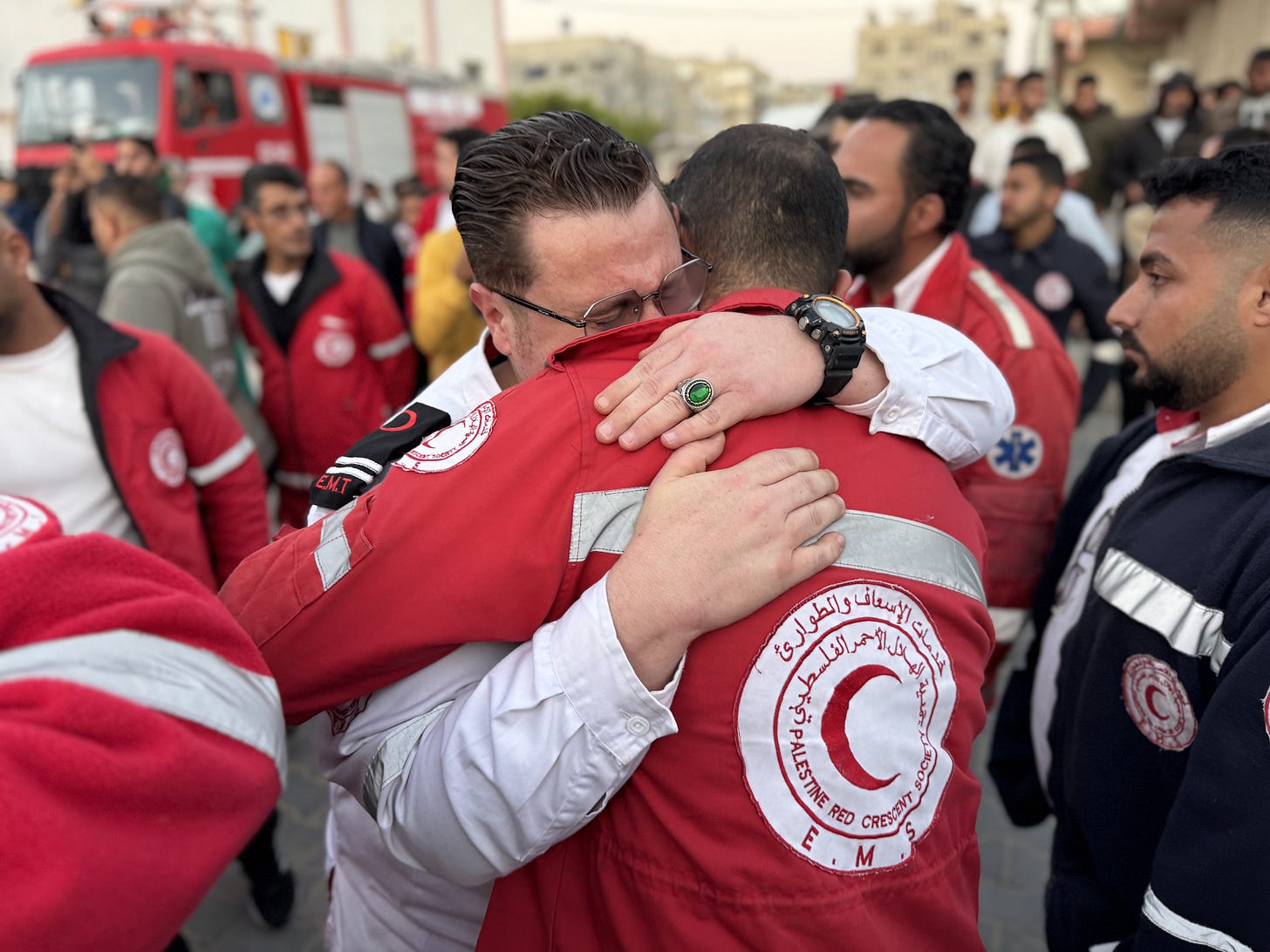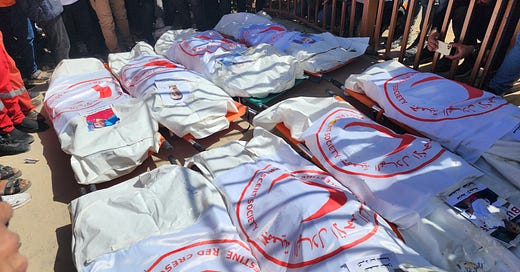Red Crescent Worker Who Survived Israeli Massacre Recounts Horror
In one of the deadliest attacks on emergency workers in the world in years, Israeli troops killed 15 Palestinian first responders and buried them in a mass grave.

On March 30, the bodies of over a dozen Palestinian first responders were found in a mass grave in the southern city of Rafah. In a war already defined as one of the deadliest attacks on journalists and aid workers in history, the massacre sent shockwaves across Gaza. Rescue crews discovered the bodies of 13 Palestinian paramedics—eight from the Red Crescent and five from the Palestinian Civil Defense, tasked with protecting and assisting civilians—along with one United Nations staffer. The body of one Civil Defense worker had been discovered three days earlier, bringing the total number of emergency and aid workers killed to 15. One of the Red Crescent’s paramedics, Asaad Al-Nasasra, is still missing.
Amid what the United Nations has described as a “concerted policy to destroy Gaza’s healthcare system,” the Red Cross and Red Crescent said it was the single deadliest attack on their workers anywhere in the world since 2017. Gaza’s Civil Defense, likewise, called it “one of the most heinous massacres” they have witnessed.
“We were directly and deliberately shot at,” Munther Abed, the only known surviving paramedic, said in an interview with Drop Site News. He said that their ambulance was clearly marked as a medical vehicle and had its lights on as further indication. “The car is clearly marked with ‘Palestinian Red Crescent Society 101.’ The car’s number was clear and the crews’ uniform was clear, so why were we directly shot at? That is the question.”
In a video taken on March 30 by the UN Office for the Coordination of Humanitarian Affairs (OCHA), the bodies are seen being excavated and placed into white body bags. “One by one, they were hit, they were struck,” Jonathan Whittall, an OCHA official, says from the site. “Their bodies were gathered and buried in this mass grave.” He added that the grave was marked by the emergency light from an ambulance.
The medics were killed just a few days after Israel broke the ceasefire in Gaza on March 18, with relentless and brutal attacks by air and ground, which has since killed more than 1,200 Palestinians. Israel’s assault on Rafah on March 23 marked a particularly chaotic and bloody day for civilians.
Eyewitness Testimony
Early in the morning on the day of the massacre, Abed said he and two of his colleagues, Mustafa Khafaja and Ezz El-Din Shaat, were dispatched to a home in western Rafah that had been bombed. “We headed out in our car and went directly to the attack site,” Abed said. “Our car was distinctive: the siren light was working, the exterior and interior lights were on.”
He was sitting in the back of the ambulance while Khafaja and Shaat were in the front, he said, when they came under intense direct fire from Israeli forces. Abed threw himself to the floor of the van. “I wasn’t hearing any sounds or words from my colleagues. The only thing I heard was their last gasp before they died,” he said.
“Suddenly, I heard people around me speaking Hebrew. Then, they opened the door and special forces came in. I recognized them from their uniforms,” he recalled. “They dragged me out of the car and took me to the sand nearby. They tortured me and beat me.” He said that, after this, he could not see much because they continued to push his face in the sand and then took him to a different location not far away. Israeli forces, he said, threw him into a ditch and repeatedly beat him with their rifles.
After losing contact with them, the Red Crescent dispatched three other ambulance crews to help their colleagues, but just after 7:30 a.m., they announced that they had lost contact with the other crews as well. A team from Gaza’s Civil Defense had tried to reach the site as well to help the other first responders, but they also lost contact with them shortly after.
Abed was still nearby, and he said Civil Defense vehicles then arrived at the scene. “There were civil defense vehicles coming, so he [the soldier] fired directly at them. After that, he moved me to another location, put me behind a wall, and I saw red [license] plates...I couldn't see the scene, but I heard gunfire.”
Hours passed where he was held with other civilians, he said. By the next morning on Monday, he was able to see the site where he and his colleagues had first arrived. “The tanks, quadcopters, drones, and vehicles started arriving. They surrounded the entire place and dug a large hole. They crushed and buried all the cars—the Red Crescent and Civil Defense cars. They buried everything and covered it with sand.”
Satellite imagery from March 23 published by Al Jazeera shows the white emergency vehicles clustered on the side of the road in western Rafah at approximately 11 a.m.—with multiple Israeli tanks in the surrounding area. By Tuesday, March 25, satellite imagery of the same location showed the land marked with dark treads covering the area, and the vehicles were less visible than before. In the imagery from Tuesday, an earthen or sand barrier was now on the road, blocking access to the site.
After being detained and abused for hours, Abed said he was finally released after soldiers told him they had checked his ID with the Shin Bet, Israel’s domestic security agency. With Rafah under evacuation orders, he said he walked barefoot to Khan Younis.
“After being tortured and beaten and all that, I felt like walking away from this place I'm in.” He is the only known survivor of the massacre.
Escalating Displacement
The Red Crescent made repeated requests on March 23 to the Israeli military to let rescue crews go to their injured colleagues, but they were refused. This marked the beginning of nearly a week-long delay until the Israeli military finally approved access to the site.
In the days between March 18, when the Israeli military resumed its scorched earth bombing and ground assault, and March 23, over 140,000 Palestinians were forcibly displaced. But the situation worsened for residents of western Rafah on that Sunday, with tens of thousands forced to flee under intensified Israeli attacks and confusing displacement orders by the Israeli military.
Photos and videos from journalists in Rafah that day documented all too familiar scenes of Palestinians fleeing on foot with any belongings they could carry on their back and in carts. Many described seeing fleeing civilians being shot at by Israeli forces. “It was the very definition of Hell. The details of it are like the horrors of the Day of Judgment,” journalist Mustafa Jabr, who had been in the area of Tal al-Sultan in western Rafah that day, told Drop Site. “Shooting. Injuries. Everyone is running, old and young, children. The elderly were left behind and people were running, because they can't walk. The artillery shelling was to our left and to our right.”
Munther Abed saw children who had been shot while he was being detained, he said, “Amongst the children and women, there was a mother with her young son, a martyr, shot in the chest. Another one was with her young daughter, also shot in the chest.”
Many Rafah residents had not even been aware of the evacuation orders on Sunday. Alaa Hassan, 23 years old, told Drop Site that he had been finishing work when he and his colleagues realized their building was surrounded by Israeli forces. “We were surprised by a belt of fire in front of us and a number of artillery shells, as well as missiles from warplanes and gunfire from quadcopters.” He said that when one of his colleagues got to the door, he was shot by ground troops. “We pulled him, started treating him immediately, and performed first aid to stop the bleeding.”
In a video Hassan shared with Drop Site, his colleague, Mohammed, can be seen being held by another co-worker. Blood was on the ground, and gunfire and airplanes were audible outside. Trying to get medical help right then proved impossible due to the attack on the paramedics, according to Hassan. “At that moment, I called the Red Crescent to ask for help. We were surprised to be informed that ambulances were near the barracks and that the occupation forces had surrounded them.” They were eventually able to flee and meet with their relatives, he said, and also bring Mohammed to be treated in Khan Younis. ”We left with nothing, leaving behind everything we owned.”
In the days that followed, civilians were repeatedly targeted by Israeli forces. Salma Kaddoumi, a journalist who was in western Rafah on Wednesday, March 26, told Drop Site that Israeli tanks were firing on the tents of displaced people that day. The UN team that was part of the rescue missions for the emergency crews also witnessed civilians being shot that same day as they tried to flee in western Rafah. In a video taken from inside the UN convoy, the body of a wounded woman is in front of the UN vehicle—with an official over the radio asking if the civilian can be reached. Before the UN officials in the car can answer, the footage shows two civilians approaching the body before they run and fall to the ground. “Another one shot,” one person in the car repeats.
By Thursday, March 27, teams from OCHA, the Red Crescent and Civil Defense were able to reach the site briefly and found the body of the Civil Defense officer who had led their rescue mission, Anwar al-Attar. According to the Civil Defense, his body was found dismembered. “We found our cars, our vehicles, and the Red Crescent vehicles in the barracks area,” spokesperson Mahmoud Basal said the next day in a video posted online. “They were bombed and fired at heavily which confirms that something bad has happened to our crews.” The teams were forced to leave the area before they could continue searching.
Finally, on Sunday, one week after the attack, the teams were able to reach the site once more and recover the bodies of the other paramedics, except for the Red Crescent medic who is still missing, Asaad Al-Nasasra. On Monday, after Abed said he saw the emergency vehicles crushed and buried, he said he also saw Asaad being held.
“The last time I saw Asaad, he was in the pit we were in. The soldiers were surrounding us. He was tied up, blindfolded and stripped off of his clothes except his undershorts. That was the last time I saw him,” Abed said. “I don’t know what happened to him afterwards.”
Video from the OCHA team shows the emergency vehicles completely crushed and with crews digging the bodies out of the grave. In a statement, Basal said that the grave was two to three meters deep, and that the paramedics had all been executed. “One of them had his clothes removed from his upper body and another one was beheaded,” according to Basal. “The least harmed among them had at least 20 bullets fired at him.” A forensic analyst who examined five of the bodies told The Guardian, “All cases had been shot with multiple bullets, except for one, which could not be determined due to the body being mutilated by animals like dogs, leaving it almost as just a skeleton.”

International Inaction
On Thursday, an Israeli military spokesperson said that they would be opening an investigation into the attack. This followed previous statements where the military said that “the IDF did not randomly attack an ambulance” and that there were vehicles that “advanced suspiciously” and without emergency lights towards ground troops on March 23. The Israeli military also stated that they killed members of Hamas, including Mohammad Amin Ibrahim Shubaki, but his body was not among those recovered at the site.
The Israeli military did not immediately respond to questions submitted by Drop Site News about the attack.
The Israeli military has repeatedly attacked medical workers, hospitals and aid workers throughout the war, claiming without verified evidence that Hamas is working or operating from medical facilities or is part of convoys. On the same day as the attack on the paramedics in Rafah, the Israeli military bombed Nasser Hospital in Khan Younis, killing a 16 year-old boy and Ismail Barhoum, a member of Hamas’s political bureau who was undergoing medical treatment.
“The presence of military activity in healthcare facilities, if confirmed, may result in the loss of the protected status of the facility itself, but medical personnel, and patients do not,” Francesca Albanese, the UN Special Rapporteur for the Occupied Territories, told Drop Site. “In the past 18 months, Israel has not presented credible evidence of military activity or significant combatants' presence in the hospitals it has targeted and often destroyed. This has resulted in the killing of more than 1,000 healthcare workers' lives while another significant number has been detained and often tortured, sometimes to death.”
Previous coordination between medical and aid convoys and the Israeli military has also not guaranteed safety. On January 29, 2024, Israeli troops attacked and killed two Red Crescent paramedics who were en route to save five year-old Hind Rajab in Gaza City. The ambulance’s route had been coordinated and approved by COGAT, according to both the Red Crescent and COGAT. In a May 2024 report, Human Rights Watch documented eight attacks on previously coordinated aid convoys that killed at least 31 aid workers and civilians with them, including an April 2024 attack that killed seven World Central Kitchen aid workers.
But even after more than a year of the war, the attack on the medical workers on March 23 was particularly shocking. In a briefing to the press from Gaza on Wednesday, Whittall said it was “very emblematic of the point we’ve reached in Gaza. What is happening here is defying—it defies decency, it defies humanity, it defies the law. It is a war without limits.”
For Munther Abed, he said what he experienced that day continues to haunt him.
“I love working as a paramedic and I love to help people. My colleagues are like my brothers, my second family,” Abed said of his colleagues who were killed. “This is not the first violation and there have been many violations before. Where is our protection according to international humanitarian law?”
“I have nightmares of what I witnessed when I sleep.”
Sharif Abdel Kouddous, Zaki Awadallah, and Jawa Al Muzaiel contributed to this article.






But they aren't crimes against humanity when MY preferred in-group commits them.
Utterly reprehensible.